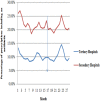Impact of the zero-mark-up drug policy on drug-related expenditures and use in public hospitals, 2016-2018: an interrupted time series study in Shaanxi
- PMID: 33243788
- PMCID: PMC7692976
- DOI: 10.1136/bmjopen-2020-037034
Impact of the zero-mark-up drug policy on drug-related expenditures and use in public hospitals, 2016-2018: an interrupted time series study in Shaanxi
Abstract
Objective: The aim of this study was to measure the impact of zero-mark-up drug policy (ZMDP) on drug-related expenditures and use in urban hospitals.
Design: This was a retrospective observational study of trends in drug expenses and use in the context of the ZMDP using an interrupted time series analysis.
Setting: Twelve hospitals (three tertiary hospitals and nine secondary hospitals) in Xi'an, which is the capital of Shaanxi Province in Western China.
Data and participants: The prescription information for all outpatients and inpatients in the study hospitals from January 2016 to April 2018 was used in this study.
Interventions: The Chinese government announced the policy intervention measure of the ZMDP, which was implemented in all public hospitals as of 1 April 2017.
Primary measures: Monthly drug expenditures, monthly medical expenditures, the percentage of drug expenditures among total medical expenditures, the average outpatient drug expenditure per visit, the percentage of prescriptions that include an injection and the percentage of prescriptions that include an antibiotic.
Results: Monthly total medical expenses increased in both tertiary and secondary hospitals after the ZMDP was implemented. In tertiary hospitals, the average outpatient drug expenditures per visit showed a slow decreasing trend before the intervention and an increasing trend after the intervention, with statistically significant changes in both the level (p<0.001) and the trend (p=0.02). Secondary hospitals showed a slow increasing trend both before and after the policy implementation, with no significant change in the trend (p=0.205). The proportion of prescriptions, including injections, was over 20% in secondary hospitals and less than 20% in tertiary hospitals, with no significant changes to this indicator observed after implementation of ZMDP.
Conclusions: The effect of the ZMDP on drug-related expenditures and use in Chinese public hospitals was not substantially evident. Future pharmaceutical reform measures should give more consideration to physician prescription behaviours.
Keywords: China; drug expenditure; drug use; hospital; interrupted time series analysis; zero mark-up drug policy.
© Author(s) (or their employer(s)) 2020. Re-use permitted under CC BY-NC. No commercial re-use. See rights and permissions. Published by BMJ.
Conflict of interest statement
Competing interests: None declared.
Figures








Similar articles
-
Impact of China's zero mark-up drug policy on drug cost of NCDs' outpatients: an interrupted time series analysis.BMC Health Serv Res. 2021 Apr 29;21(1):404. doi: 10.1186/s12913-021-06414-3. BMC Health Serv Res. 2021. PMID: 33926444 Free PMC article.
-
Impacts of the zero mark-up drug policy on hospitalization expenses of COPD inpatients in Sichuan province, western China: an interrupted time series analysis.BMC Health Serv Res. 2020 Jun 8;20(1):519. doi: 10.1186/s12913-020-05378-0. BMC Health Serv Res. 2020. PMID: 32513170 Free PMC article.
-
Impacts of the zero mark-up policy on hospitalization expenses of T2DM and cholecystolithiasis inpatients in SC province, western China: an interrupted time series analysis.Front Public Health. 2023 Apr 28;11:1079655. doi: 10.3389/fpubh.2023.1079655. eCollection 2023. Front Public Health. 2023. PMID: 37188279 Free PMC article.
-
Hong Kong's domestic health spending--financial years 1989/90 through 2004/05.Hong Kong Med J. 2008 Apr;14 Suppl 2:2-23. Hong Kong Med J. 2008. PMID: 18587162 Review.
-
A systematic review of policies regulating or removing mark-ups in the pharmaceutical supply and distribution chain.Health Policy. 2023 Dec;138:104919. doi: 10.1016/j.healthpol.2023.104919. Epub 2023 Sep 28. Health Policy. 2023. PMID: 37788559
Cited by
-
Impact of China's zero mark-up drug policy on drug cost of NCDs' outpatients: an interrupted time series analysis.BMC Health Serv Res. 2021 Apr 29;21(1):404. doi: 10.1186/s12913-021-06414-3. BMC Health Serv Res. 2021. PMID: 33926444 Free PMC article.
-
Intended and unintended impacts of the comprehensive reform of urban public hospitals: A mixed-method study in Hangzhou, China.Front Public Health. 2022 Oct 10;10:979455. doi: 10.3389/fpubh.2022.979455. eCollection 2022. Front Public Health. 2022. PMID: 36299745 Free PMC article.
-
Impact of zero-mark-up medicines policy on hospital revenue structure: a panel data analysis of 136 public tertiary hospitals in China, 2012-2020.BMJ Glob Health. 2021 Nov;6(11):e007089. doi: 10.1136/bmjgh-2021-007089. BMJ Glob Health. 2021. PMID: 34725041 Free PMC article.
-
Differences in inpatient performance of public general hospitals following implementation of a points-counting payment based on diagnosis-related group: a robust multiple interrupted time series study in Wenzhou, China.BMJ Open. 2024 Mar 12;14(3):e073913. doi: 10.1136/bmjopen-2023-073913. BMJ Open. 2024. PMID: 38471900 Free PMC article.
-
The Impact of Sanming Healthcare Reform on Antibiotic Appropriate Use in County Hospitals in China.Front Public Health. 2022 Jun 27;10:936719. doi: 10.3389/fpubh.2022.936719. eCollection 2022. Front Public Health. 2022. PMID: 35832279 Free PMC article.
References
-
- World Health Organization The rational use of drugs. Report of the conference of experts. Geneva: WHO, 1985.
-
- World Health Organization Medicines use in primary care in developing and transitional countries: fact book Summarizing results from studies reported between1990 and 2006. Geneva: WHO, 2009.
-
- World Health Organization Medicines: rational use of medicines. WHO 2010.
-
- Kathleen H, Liset VD. The world medicines situation: rational use of medicines. Geneva: World Health Organization, 2010.
Publication types
MeSH terms
Substances
LinkOut - more resources
Full Text Sources
Medical
Miscellaneous
